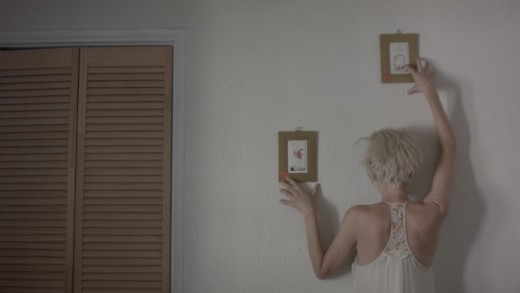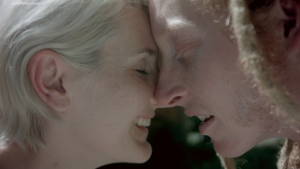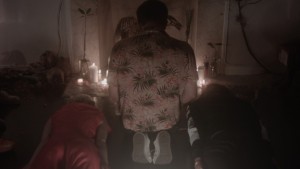A Love Song to Tender Fruition and Decay: Hearts of Palm
Monica Uszerowicz
 Monica Peña, Hearts of Palm, 2016
Monica Peña, Hearts of Palm, 2016
“Lovesong” is not the only literary or otherwise creative reference Hearts of Palm will make, as it draws on numerous filmmakers, writers, and their storied love affairs to help tell its tale—Simone de Beauvoir and Jean-Paul Sartre are given poignant mention, and Chantal Akerman, whose suicide came as the film’s production wrapped, is noted for the intimate honesty in her portrayal of women’s emotional landscapes (it’s an observable influence on Peña’s work). The most pertinent of these stories is Peña’s own: acting as narrator, she reveals that she, like so many male directors before her, cast a former lover as her lead, their time together ending during filming. It’s clear we are watching two stories: one in which Peña re-tells the narrative of a self-described broken heart, and the fable therein—the deterioration of El and Ella, based on some truth.
In her last film, Ectotherms—which earned Peña the title of Knight Fellow and sent her to the Sundance Film Festival in 2014—there were few obvious demarcations between fiction and nonfiction; in Hearts of Palm, our honest narrator offers commentary about the space between artifice and reality, the heartache of the directive process, the falling flat of specific moments. It’s a testament to El and Ella’s tension that, even with Peña’s literal voice—which appears infrequently enough to allow willful suspension of disbelief—we do not lose sight of her aesthetic voice. It is easy to become absorbed in the on-screen relationship, despite knowing full well its off-screen inspiration.
Portrayed in several segments, Hearts of Palm’s initial warmth is fleeting. The singing birds and slippery kisses of the first chapter, “Garden Bed,” are cut short by Ella’s vomiting. It is merciless; there is blood in the toilet and nothing with which to clean her face. Once inside the house, without the distractions of the sunshine, the architectural decay is palpable. We are trained to think of pregnancy when we see a woman, in love and on film, grow nauseous, but these two have nothing to birth. In her disgust, Ella scolds El about the state of the home (and lack of toilet paper), leaving him scoffing and stressed on the edge of the tub.

Monica Peña, Hearts of Palm, 2016

It’s difficult to say if Hearts of Palm unfolds over one day or many. What’s more important is that it happens in such cramped quarters, in a house that starts to take on fairytale qualities, given the unlikelihood that one wouldn’t attempt, at some point, to escape. Barring one scene, El and Ella never leave, trapped in the metaphorical tower. In his 1958 book The Poetics of Space, Gaston Bachelard wrote, “For a knowledge of intimacy, localization in the spaces of our intimacy is more urgent than determination of dates.” The house tells the story and creates the memory, no matter how long (or how long ago) it was. As their home begins to mime the disrepair of their love—the way one’s environment often mimics one’s spiritual interior—their awkwardness makes whatever eerie force is about to descend upon them seem increasingly sinister. How can two people, barely able to look each other in the eye, handle something dark and unknown? Worse, what if they’re the source of that great, unseen turmoil?
Throughout the dense silence, the film remains beautiful, lit as romantically as any midday afternoon in the tropics and keen in its attention to pretty, comforting detail. Everything looks rich and awash in light. Production designer Lucila Garcia de Onrubia has created a space for El and Ella—and the viewers—to dream. Lovett, who is also electronic musician Dim Past, scored the film (a few scenes in particular, as music is used sparingly), and when his character—in another moment of art imitating life—improvises a song, the constant unease is momentarily forgettable. Peña finds poetry in the day-to-day, in the ugly and redundant; cinematographer Jorge Rubiera approaches dead insects, Ella brushing her teeth, and the lovers’ early embraces with equal affection. That Miami is a character of its own becomes explicit only slowly, and Rubiera is judicious in what he shares to reveal the film’s city of origin: patches of light, the singing-roar of a train, dried centipede carcasses. We hear, intermittently, “El la amaba y ella lo amaba”—“he loved her and she loved him”—the first line of Hughes’s poem translated into Spanish. Peña is an experimental and meandering filmmaker, to be sure; to watch Hearts of Palm is to traverse, in equal strides, her consciousness, a fictional relationship, and the city of Miami.
After El and Ella find what appears to be a religious symbol drawn with mangroves (and more deceased reptiles) on their porch, they are granted reprieve from their self-imposed prison with a visit to a botanica, seeking advice and the eradication of something ghostly. Their Spanglish conversation with the unnamed expert and shopkeeper—local Eloisa Garcia—will be familiar to Miamians, whose city is bilingual and who understand that, if they are not bilingual themselves, body language speaks volumes. Garcia offers the pair ritualistic tools for cleansing, and together they laugh and take turns holding a dove in their palms. “For peace in the world,” they determine. Upon their return home, what follows are scenes unlike the rest, far from peaceful and wholly terrifying, severing Hearts of Palm into two distinct halves: pre-botanica and post-botanica. In this maybe-dream sequence, there is sudden noise, inexplicable magic, and, finally, a release from the apprehension. With assistance by a mystery man-cum-stand-in-Santero, played by fellow Miami filmmaker Julian Yuri Rodriguez, we learn that the impending doom of Hearts of Palm is El and Ella themselves, and there is only one way to absolve them of it—though it’s less macabre than it seems.
By the time it’s over, Hearts of Palm feels like an unnerving fever dream or deeply embedded spiritual memory. In some ways, it is: Peña has left us in the wake of a gorgeous ceremonial ritual, both the one in the film and the film itself. For a movie that owes so much to stillness and quiet, there is a whirlwind of material to be parsed through, from the depth of its cultural allusions to its backstory. Indeed, there is enough to implicate all of its references that the story could run the risk of getting lost, buried beneath its sources. Yet it doesn’t—the painful veracity of the couple’s disintegration and Peña’s narrative hold steadfast: you cannot look away. Love stories, like all stories, are multitudinous beasts, comprising too many histories to pinpoint. Whether or not they matter in the end is anybody’s guess.
Monica Uszerowicz has contributed writing and images to publications like V, Dossier, Hyperallergic, and Artsy, and is the film and performing arts editor of the Miami Rail.









